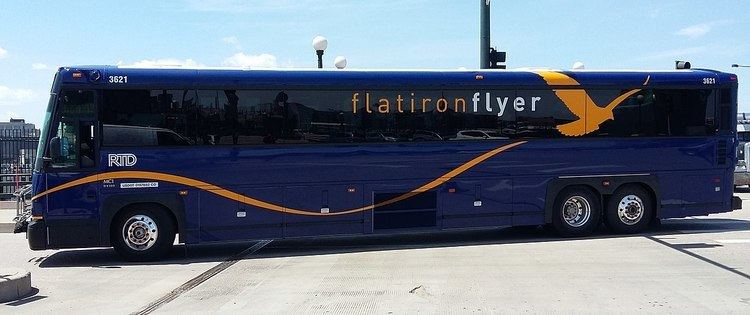Began service January 3, 2016 | ||
 | ||
Vehicle 56 Motor Coach Industries D4500CL coaches Status open, construction continues Predecessors Routes 86x, BV, BF, BMX, BX, HX, S, T | ||
Flatiron Flyer is an 18-mile (29 km) express bus line between Denver and Boulder, Colorado, traveling along U.S. Route 36. Different levels of service are available, including a non-stop from Boulder to Union Station in high-occupancy toll lanes (HOT lanes), and all-stop, which serves six park-and-rides along U.S. Route 36 in normal highway lanes. The line branches out to different destinations in Denver and Boulder. The Regional Transportation District operates the line, opened on January 3, 2016. The ITDP classified the system as "not bus rapid transit", due to the use of lanes shared with private cars along US 36, lack of street level boarding/alighting and the lack of an off-board fare system. This new system has been criticized as bus rapid transit creep.
Contents
Route
A branching route system is employed, with the backbone of the system being the HOT lanes along U.S. Route 36. High-occupancy vehicles and buses travel free in the HOT lanes, while single-occupancy vehicles must pay between $1.25 to $7.60, depending on time of day, or up to $13.68 without an electronic toll collection pass. The HOT lane will be managed to ensure that traffic will flow at 50 to 55 miles per hour. Union Station, Civic Center and Anschutz Medical Campus serve as the termini in Denver, while Downtown Boulder and Boulder Junction are the termini in Boulder.
Due to the fact that Flatiron Flyer travels with other vehicles in the HOT lanes, the lack of street level boarding and alighting and the lack of an off-board fare system, it has been classified as "Not BRT" by the Institute for Transportation and Development Policy, which promotes construction of BRT systems.
Stops
There are six park-and-rides along U.S. Route 36 from Denver to Boulder, which have been dubbed "stations", that will be served by Flatiron Flyer:
These stops will have ticket vending machines, and passenger information systems.
Service
Express service between Boulder and Denver is expected to take slightly under an hour, which is about 10 to 15 minutes faster than current bus routes.
There was some opposition to the proposed consolidation of routes between Boulder and Denver. Buses along the most popular routes would come more frequently under the new service plan, but Boulder Junction would receive less service.
Proposed service plan
Headways along different routes vary based on the time of day.
History
Flatiron Flyer was constructed as part of the FasTracks program, which built six new commuter rail, light rail, and bus rapid transit lines in the Denver metropolitan area.
Widening U.S. Route 36 to accommodate the bus line was a joint project between the Colorado Department of Transportation and RTD, termed the US 36 Express Lanes Project. The highway will be widened by 40 feet (12 m) in each direction to allow the addition of a high-occupancy vehicle lane, in which the non-stop bus service will travel. The project will be completed in two phases, with the first phase beginning in July 2012 and ending in July 2015. It cost $317 million and extended from Federal Boulevard to 88th Street in Louisville, Colorado. Phase 2 of the project, anticipated to be complete by early 2016, will extend the HOT lanes from 88th Street to Table Mesa Drive in Boulder, Colorado through a public–private partnership. To accommodate the lanes, several bridges were replaced and shoulders were widened along the highway.
Fleet
RTD purchased 59 D4500CL buses from Motor Coach Industries for $35 million to be used on the line. Each bus can carry up to 57 passengers.
The University of Colorado paid $5 million over five years to place advertisements on Flatiron Flyer buses.
Criticism
Originally, the voter-approved plan called for a 41-mile (66 km) high-capacity commuter rail line running from Denver Union Station to Longmont, passing through North Denver, Adams County, Westminster, Broomfield, Louisville and Boulder. The completion of this original plan has been delayed until 2044 due to lower tax revenues and higher costs than expected. As an interim measure, RTD will introduce a new bus system, branded "Flatiron Flyer", traveling in high-occupancy toll lanes along US 36 between Denver and Boulder. The consolidation of current express service between Denver and Boulder into this one system attracted criticism from Boulder residents, since increased frequencies would be balanced with some service cuts. Additionally, the ITDP classified the system as "not bus rapid transit", due to the use of lanes shared with private cars along US 36.
